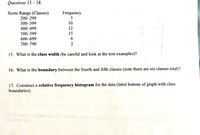
MATLAB: An Introduction with Applications
6th Edition
ISBN: 9781119256830
Author: Amos Gilat
Publisher: John Wiley & Sons Inc
expand_more
expand_more
format_list_bulleted
Question

Transcribed Image Text:Questions 15 – 18.
Score Range (Classes)
Frequency
200–299
300–399
10
400–499
12
500–599
15
600-699
700–799
2
15. What is the class width (be careful and look at the text examples)?
16. What is the boundary between the fourth and fifth classes (note there are six classes total)?
17. Construct a relative frequency histogram for the data (label bottom of graph with class
boundaries).
CHASS

Transcribed Image Text:18. If you were to construct a Pareto chart for this data, which class (Score Range) would
appear first (on the left of the graph)?
19. If 8% of the human population have blue eyes, how many blue-eyed people would you
expect to have in a random sample of 700 people?
Expert Solution
arrow_forward
Step 1
The frequency table can be given as:
| Classes | Frequency |
| 199.5-299.5 | 5 |
| 299.5-399.5 | 10 |
| 399.5-499.5 | 12 |
| 499.5-599.5 | 15 |
| 599.5-699.5 | 6 |
| 699.5-799.5 | 2 |
| Total | 50 |
Trending nowThis is a popular solution!
Step by stepSolved in 2 steps

Knowledge Booster
Similar questions
- The data in the relative frequency bar graph below represents the number of stars earned by 140 performers in a talent competition. 35 30 25 20 15 10 1 Number of Stars How many performers earned exactly 3 stars? Be careful - compare the question wording to the scale on the y-axis of the graph. Notice it says "percentage of performers" Percentage of Performers (N = 140) N 寸arrow_forwardIn the frequency distribution below, the first column (class limits) gives the age ranges (in years) of people who participate in a survey. The second column gives the frequency for each age range. a. Determine the class width. If needed, you can use the space below the table. b. Complete the rest of the frequency distribution. For the relative frequency column, round your answers to 2 decimal places. Class Limits Frequency Class Boundaries Class Midpoints Relative Frequency Cumulative Frequency 18-26 16 27-35 24 36-44 38 45-53 34 54-62 26 63-71 12 Total 150arrow_forwardUse the Histogram tool to develop a frequency distribution and histogram for the number of months as a customer of the bank in the data below. Compute the relative and cumulative relative frequencies and use a line chart to construct an ogive. Complete the frequency distribution for the months as a customer, and compute the relative and cumulative relative frequencies. (Type integers or decimals rounded to three decimal places as needed.) Bins Frequency Relative Frequency Cumulative Relative Frequency 10 enter your response here enter your response here enter your response here 20 enter your response here enter your response here enter your response here 30 enter your response here enter your response here enter your response here 40 enter your response here enter your response here enter your response here 50 enter your response here enter your response here enter your…arrow_forward
- The data in the relative frequency bar graph below represents the number of stars earned by 140 performers in a talent competition.How many performers earned exactly 5 stars? Be careful - compare the question wording to the scale on the y-axis of the graph. Notice it says "percentage of performers"arrow_forwardThe data represent the time, in minutes, spent reading a political blog in a day. Construct a frequency distribution using 5 classes. In the table, include the midpoints, relative frequencies, and cumulative frequencies. Which class has the greatest frequency and which has the least frequency? 15 14 4 7 19 12 16 5. 10 17 17 18 14 10 6 Complete the table, starting with the lowest class limit. (Simplify your answers.) Relative Cumulative Class Frequency Midpoint Frequency Frequency Which class has the greatest frequency? The class with the greatest frequency is from to Which class has the least frequency? The class with the least frequency from toarrow_forwardPlease help asaparrow_forward
arrow_back_ios
arrow_forward_ios
Recommended textbooks for you
 MATLAB: An Introduction with ApplicationsStatisticsISBN:9781119256830Author:Amos GilatPublisher:John Wiley & Sons Inc
MATLAB: An Introduction with ApplicationsStatisticsISBN:9781119256830Author:Amos GilatPublisher:John Wiley & Sons Inc Probability and Statistics for Engineering and th...StatisticsISBN:9781305251809Author:Jay L. DevorePublisher:Cengage Learning
Probability and Statistics for Engineering and th...StatisticsISBN:9781305251809Author:Jay L. DevorePublisher:Cengage Learning Statistics for The Behavioral Sciences (MindTap C...StatisticsISBN:9781305504912Author:Frederick J Gravetter, Larry B. WallnauPublisher:Cengage Learning
Statistics for The Behavioral Sciences (MindTap C...StatisticsISBN:9781305504912Author:Frederick J Gravetter, Larry B. WallnauPublisher:Cengage Learning Elementary Statistics: Picturing the World (7th E...StatisticsISBN:9780134683416Author:Ron Larson, Betsy FarberPublisher:PEARSON
Elementary Statistics: Picturing the World (7th E...StatisticsISBN:9780134683416Author:Ron Larson, Betsy FarberPublisher:PEARSON The Basic Practice of StatisticsStatisticsISBN:9781319042578Author:David S. Moore, William I. Notz, Michael A. FlignerPublisher:W. H. Freeman
The Basic Practice of StatisticsStatisticsISBN:9781319042578Author:David S. Moore, William I. Notz, Michael A. FlignerPublisher:W. H. Freeman Introduction to the Practice of StatisticsStatisticsISBN:9781319013387Author:David S. Moore, George P. McCabe, Bruce A. CraigPublisher:W. H. Freeman
Introduction to the Practice of StatisticsStatisticsISBN:9781319013387Author:David S. Moore, George P. McCabe, Bruce A. CraigPublisher:W. H. Freeman

MATLAB: An Introduction with Applications
Statistics
ISBN:9781119256830
Author:Amos Gilat
Publisher:John Wiley & Sons Inc

Probability and Statistics for Engineering and th...
Statistics
ISBN:9781305251809
Author:Jay L. Devore
Publisher:Cengage Learning

Statistics for The Behavioral Sciences (MindTap C...
Statistics
ISBN:9781305504912
Author:Frederick J Gravetter, Larry B. Wallnau
Publisher:Cengage Learning

Elementary Statistics: Picturing the World (7th E...
Statistics
ISBN:9780134683416
Author:Ron Larson, Betsy Farber
Publisher:PEARSON

The Basic Practice of Statistics
Statistics
ISBN:9781319042578
Author:David S. Moore, William I. Notz, Michael A. Fligner
Publisher:W. H. Freeman

Introduction to the Practice of Statistics
Statistics
ISBN:9781319013387
Author:David S. Moore, George P. McCabe, Bruce A. Craig
Publisher:W. H. Freeman